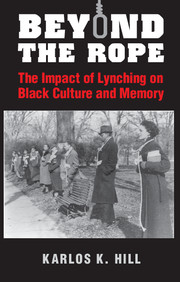Introduction
Published online by Cambridge University Press: 05 July 2016
Summary
James Allen, an Atlanta-based antiques collector, debuted Witness: Photographs of Lynchings from the Collection of James Allen at the Ruth Horowitz Gallery in Manhattan in January 2000. The exhibit displayed sixty photographs and postcards of lynchings that primarily depicted white-on-black lynch mob violence. It created an immediate buzz. People waited for hours in long lines to view the collection, which led the gallery to issue two hundred tickets per day. At least five thousand people viewed the exhibit before it closed. Subsequently, James Allen renamed the exhibit Without Sanctuary and redisplayed the photographs at the New York Historical Society between March 14 and October 1, 2000, during which time more than fifty thousand people viewed the collection. From there, it was exhibited in Pittsburg, Atlanta, and even at the Sorbonne in Paris. Altogether, between 2000 and 2009, Without Sanctuary was exhibited eight times. Even though Allen and museum curators modified or changed some aspects at each new site, the exhibition set attendance records for the host museums. Based upon the exhibit's popularity, Twin Palms Press published ninety-eight of Allen's lynching photos and postcards in Without Sanctuary: Lynching Photography in America in late 2000. Since publication, it has sold over sixty thousand copies. Thus, perhaps more than any other individual in the past two decades, James Allen has inserted the history of lynching into mainstream consciousness.
The Without Sanctuary exhibition and book showcase the most familiar images of American lynching – images of white lynchers surrounding a lynched black body. Contrary to the original intent of lynching photographs, Without Sanctuary employs these images for the purpose of perpetuating a victimization narrative of the lynched black body. This narrative hinges upon highlighting white brutality against blacks. Rhetorically, Without Sanctuary aims to elicit contemporary audiences’ outrage, sympathy for black lynch victims and their families, and reprobation for whites who participated in, witnessed, and condoned these brutal murders. It is an important and necessary narrative that has its roots in the National Association of the Advancement of Colored People's (NAACP) four-decade quest for a federal antilynching law during the first half of the twentieth century.
- Type
- Chapter
- Information
- Beyond the RopeThe Impact of Lynching on Black Culture and Memory, pp. 1 - 14Publisher: Cambridge University PressPrint publication year: 2016



